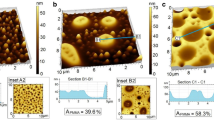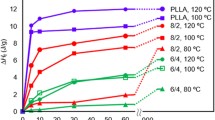Abstract
Phase separation in bulk mixtures commonly leads to an isotropic, disordered morphology of the coexisting phases1. The presence of a surface can significantly alter the phase-separation process, however2,3. Here we show that the domains of a phase-separating mixture of polymers in a thin film can be guided into arbitrary structures by a surface with a prepatterned variation of surface energies. Such a pattern can be imposed on a surface by using printing methods for depositing microstructured molecular films4, thereby allowing for such patterns to be readily transferred to a two-component polymer film. This approach might provide a simple means for fabricating polymer-based microelectronic circuits5 or polymer resists for lithographic semiconductor processing.



Similar content being viewed by others
References
Gunton, J. D., San Miguel, M. & Sahni, P. S. in Phase Transitions and Critical Phenomena (eds Domb, C. & Lebovitz, J. L.) Vol. 8, 267–466 (Academic, London, 1983).
Jones, R. A. L., Norton, L. J., Kramer, E. J., Bates, F. S. & Wiltzius, P. Surface-directed spinodal decomposition. Phys. Rev. Lett. 66, 1326–1329 (1991).
Krausch, G., Kramer, E. J., Rafailovich, M. H. & Sokolov, J. Self assembly of a homopolymer mixture via phase separation. Appl. Phys. Lett. 64, 2655–2657 (1994).
Xia, Y., Zaho, X.-M. & Whitesides, G. M. Pattern transfer: Self-assembled monolayers as ultrathin resists. Microelectr. Eng. 32, 255–268 (1996).
Service, R. F. Patterning electronics on the cheap. Science 278, 383–384 (1997).
Walheim, S., Böltau, M., Mlynek, J., Krausch, G. & Steiner, U. Structure formation via polymer demixing in spin-cast films. Macromolecules 30, 4995–5003 (1997).
Binning, G., Quate, C. F. & Gerber, C. Atomic force microscope. Phys. Rev. Lett. 56, 930–933 (1986).
Abbot, N. L., Folkers, J. P. & Whitesides, G. M. Manipulation of the wettability of surfaces on the 0.1- to 1-micrometer scale through micromachining and molecular self assembly. Science 257, 1380–1382 (1992).
Morkved, T. L., Wiltzius, P., Jaeger, H. M., Grier, D. G. & Witten, T. A. Mesoscopic self-assembly of gold islands on diblock-copolymer films. Appl. Phys. Lett. 64, 422–424 (1994).
Morkved, T. L.et al. Local control of microdomain orientation in diblock copolymer thin films with electric fields. Science 273, 931–933 (1996).
Haus, J. W. in Quantum Optics of Confined Systems (eds Ducloy, M. & Block, D.) 101–141 (Kluwer Academic, Dordrecht, 1996).
Prime, K. L. & Whitesides, G. M. Self-assembled organic monolayers: Model systems for studying adsorption of proteins at surfaces. Science 252, 1164–1167 (1991).
Halls, J.et al. Efficient photodiodes from interpenetrating networks. Nature 376, 498–500 (1995).
Acknowledgements
This work was supported by the Deutsche Forschungsgesellschaft (DFG), the Volkswagenstiftung, and NATO. U.S. acknowledges the financial support from a research fellowship (Habilitations-Stipendum) of the DFG. We thank E. J. Kramer and J. Heier for their help preparing the PDMS stamps.
Author information
Authors and Affiliations
Corresponding author
Rights and permissions
About this article
Cite this article
Böltau, M., Walheim, S., Mlynek, J. et al. Surface-induced structure formation of polymer blends on patterned substrates. Nature 391, 877–879 (1998). https://doi.org/10.1038/36075
Received:
Accepted:
Issue Date:
DOI: https://doi.org/10.1038/36075
- Springer Nature Limited
This article is cited by
-
Solvo-selective imprinting of a thin polymer blend film for creating multi-length scale patterns
Bulletin of Materials Science (2020)
-
A study on generation of embossed carbon nanopattern by induced microdomain alignments in PAN-based block copolymer under electric field
Journal of Materials Science (2018)
-
Bio-inspired strategies for designing antifouling biomaterials
Biomaterials Research (2016)
-
From self-assembled monolayers to chemically patterned brushes: Controlling the orientation of block copolymer domains in films by substrate modification
Chinese Journal of Polymer Science (2016)
-
Spontaneous bilayer phase separations of spin-coated polymer blend thin films: A neutron reflectivity study
Macromolecular Research (2016)





